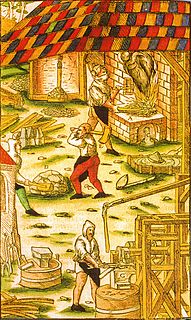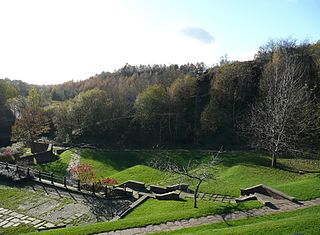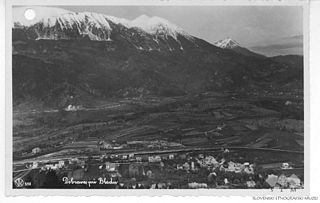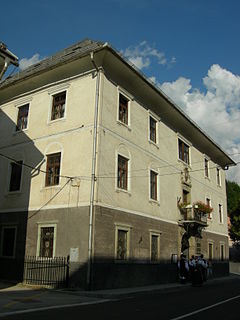
The Bucellini–Ruard Manor, commonly referred to as the Ruard Manor (Slovene : Ruardova graščina), is a 16th-century manor house located in the Sava neighbourhood of the town of Jesenice in northwestern Slovenia, at the street address of 45 France Prešeren Street (Cesta Franceta Prešerna 45). It is one of four so-called "ironworks castles" built in the area during the 16th and early 17th centuries by the owners of iron-mining and -processing facilities, in what were then the clustered settlements of Plavž, Sava, Murova and Javornik, amalgamated into the town of Jesenice in 1929. The Kos Manor in Murova also survives; the Plavž and Javornik manors were demolished.

Slovene or Slovenian belongs to the group of South Slavic languages. It is spoken by approximately 2.5 million speakers worldwide, the majority of whom live in Slovenia. It is the first language of about 2.1 million Slovenian people and is one of the 24 official and working languages of the European Union.

A manor house was historically the main residence of the lord of the manor. The house formed the administrative centre of a manor in the European feudal system; within its great hall were held the lord's manorial courts, communal meals with manorial tenants and great banquets. The term is today loosely applied to various country houses, frequently dating from the late medieval era, which formerly housed the gentry.

Stara Sava, also known as Sava, is a formerly autonomous settlement that is now part of the town of Jesenice, in the Upper Carniola region of Slovenia.
The Ruard Manor was built in 1538 by the Italian businessman Bernardo Bucellini, who had recently relocated to Sava from Bergamo and whose family would come to dominate the iron mining and processing industry of the entire upper Sava valley. Unlike the Kos manor, Bucelenni chose to locate this residence close to the ironworks themselves. The Bucellinis were very successful for a time, and were ennobled during the 17th century, taking the name "von Reichenberg" after the German name of their ore mines at Savske Jame. In 1686 the family was elevated to counthoood.

Italy, officially the Italian Republic, is a country in Europe. Located in the middle of the Mediterranean Sea, Italy shares open land borders with France, Switzerland, Austria, Slovenia and the enclaved microstates San Marino and Vatican City. Italy covers an area of 301,340 km2 (116,350 sq mi) and has a largely temperate seasonal and Mediterranean climate. With around 61 million inhabitants, it is the fourth-most populous EU member state and the most populous country in Southern Europe.
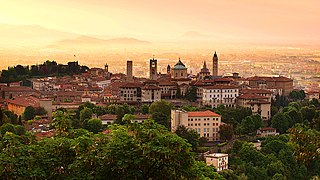
Bergamo is a city in the alpine Lombardy region of northern Italy, approximately 40 km (25 mi) northeast of Milan, and about 30 km (19 mi) from Switzerland, the alpine lakes Como and Iseo and 70 km (43 mi) from Garda and Maggiore. The Bergamo Alps begin immediately north of the city.

The Upper Sava Valley is an alpine valley in the Upper Carniola region of Slovenia. The Sava Dolinka River flows along it. It begins in Rateče at an elevation of 870 m and ends at Moste at 560 m. It is the geographical border between the Julian Alps and the Karawanks. It was created on a tectonic fault that runs down the middle of the valley. Its geomorphological forms are a result of the actions of the river and glaciers. A number of smaller valleys lead into it from both sides.
The manor gained the second half of its current name in 1766, when Valentin Ruard, a Belgian entrepreneur, bought the entire estate and restored the failing ironworks surrounding it. Leopold Ruard, his son, was mayor of Jesenice under the brief period of French rule. In 1831, the manor was expanded and reconstructed in the Neoclassical style. In the next generation, it passed out of Ruard hands, as Viktor Ruard was unable to obtain capital for the modernization of the family ironworks, and was forced to sell both them and the manor to the KID company in 1871, which converted it into clerks' housing (much like the nearby Workers' Barracks).

Belgium, officially the Kingdom of Belgium, is a sovereign state in Western Europe. It is bordered by the Netherlands to the north, Germany to the east, Luxembourg to the southeast, France to the southwest, and the North Sea to the northwest. It covers an area of 30,688 square kilometres (11,849 sq mi) and has a population of more than 11.4 million. The capital and largest city is Brussels; other major cities are Antwerp, Ghent, Charleroi and Liège.

The Illyrian Provinces were an autonomous province of France during the First French Empire that existed under Napoleonic Rule from 1809 to 1814. The Provinces encompassed modern-day Croatia, Slovenia, Gorizia, and parts of Austria. Its headquarters were stationed in Laybach, which would be renamed Ljubljana and made the capital of contemporary Slovenia. It encompassed six départments, making it a relatively large portion of territorial France at the time. Parts of Croatia were split up into Civil Croatia and Military Croatia, the former served as a residential space for French immigrants and Croatian inhabitants and the latter as a military base to check the Ottoman Empire.
Neoclassical architecture is an architectural style produced by the neoclassical movement that began in the mid-18th century. In its purest form, it is a style principally derived from the architecture of classical antiquity, the Vitruvian principles, and the work of the Italian architect Andrea Palladio.
Since 1954, the manor has served as a museum, and later became the seat of the Upper Sava Museum. [1] It hosts several permanent exhibits:
- Historical museum of the iron and steel industry in the Jesenice region, featuring tools, artifacts and motorized maquettes of industrial facilities
- Paleontological collection of the Palaeozoic flora and fauna of the western Karawanks
- Mineral collection [2]

A maquette is a scale model or rough draft of an unfinished sculpture. An equivalent term is bozzetto, from the Italian word that means 'sketch'.

The Karawanks or Karavankas or Karavanks are a mountain range of the Southern Limestone Alps on the border between Slovenia to the south and Austria to the north. With a total length of 120 kilometres (75 mi) in an east-west direction, the Karawanks chain is one of the longest ranges in Europe. It is traversed by important trade routes and has a great tourist significance. Geographically and geologically, it is divided into the higher Western Karawanks and the lower-lying Eastern Karawanks. It is traversed by the Periadriatic Seam, separating the Apulian tectonic plate from the Eurasian Plate.

A mineral is, broadly speaking, a solid chemical compound that occurs naturally in pure form. A rock may consist of a single mineral, or may be an aggregate of two or more different minerals, spacially segregated into distinct phases. Compounds that occur only in living beings are usually excluded, but some minerals are often biogenic and/or are organic compounds in the sense of chemistry. Moreover, living beings often syntesize inorganic minerals that also occur in rocks.


